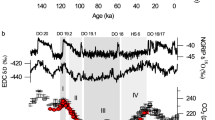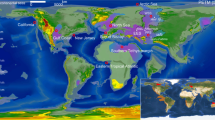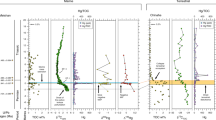Abstract
The Earth’s climate abruptly warmed by 5–8 °C during the Palaeocene–Eocene thermal maximum (PETM), about 55.5 million years ago1,2. This warming was associated with a massive addition of carbon to the ocean–atmosphere system, but estimates of the Earth system response to this perturbation are complicated by widely varying estimates of the duration of carbon release, which range from less than a year to tens of thousands of years. In addition the source of the carbon, and whether it was released as a single injection or in several pulses, remains the subject of debate2,3,4. Here we present a new high-resolution carbon isotope record from terrestrial deposits in the Bighorn Basin (Wyoming, USA) spanning the PETM, and interpret the record using a carbon-cycle box model of the ocean–atmosphere–biosphere system. Our record shows that the beginning of the PETM is characterized by not one but two distinct carbon release events, separated by a recovery to background values. To reproduce this pattern, our model requires two discrete pulses of carbon released directly to the atmosphere, at average rates exceeding 0.9 Pg C yr−1, with the first pulse lasting fewer than 2,000 years. We thus conclude that the PETM involved one or more reservoirs capable of repeated, catastrophic carbon release, and that rates of carbon release during the PETM were more similar to those associated with modern anthropogenic emissions5 than previously suggested3,4.
This is a preview of subscription content, access via your institution
Access options
Subscribe to this journal
Receive 12 print issues and online access
$259.00 per year
only $21.58 per issue
Buy this article
- Purchase on Springer Link
- Instant access to full article PDF
Prices may be subject to local taxes which are calculated during checkout



Similar content being viewed by others
References
Westerhold, T., Röhl, U. & Laskar, J. Time scale controversy: Accurate orbital calibration of the early Paleogene. Geochem. Geophys. Geosyst. 13, Q06015 (2012).
McInerney, F. A. & Wing, S. L. The Paleocene–Eocene thermal maximum: A perturbation of carbon cycle, climate, and biosphere with implications for the future. Annu. Rev. Earth Planet. Sci. 39, 489–516 (2011).
Wright, J. D. & Schaller, M. F. Evidence for a rapid release of carbon at the Paleocene–Eocene thermal maximum. Proc. Natl Acad. Sci. USA 110, 15908–15913 (2013).
Cui, Y. et al. Slow release of fossil carbon during the Palaeocene–Eocene thermal maximum. Nature Geosci. 4, 481–485 (2011).
Ciais, P. et al. in Climate Change 2013: The Physical Science Basis (eds Stocker, T. F. et al.) 465–570 (IPCC, Cambridge Univ. Press, 2013).
Kraus, M. J. & Gwinn, B. Facies and facies architecture of Paleogene floodplain deposits, Willwood Formation, Bighorn Basin, Wyoming, USA. Sed. Geol. 114, 33–54 (1997).
Bowen, G. J. et al. in Paleocene–Eocene Stratigraphy and Biotic Change in the Bighorn and Clarks Fork Basins, Wyoming (ed Gingerich, P. D.) 73–88 (Univ. of Michigan Museum of Paleontology, 2001).
Cerling, T. E. The stable isotopic composition of modern soil carbonate and its relationship to climate. Earth Planet. Sci. Lett. 71, 229–240 (1984).
Sluijs, A., Zachos, J. C. & Zeebe, R. E. Constraints on hyperthermals. Nature Geosci. 5, 231 (2012).
Kirtland Turner, S. & Ridgwell, A. Recovering the true size of an Eocene hyperthermal from the marine sedimentary record. Paleoceanography 28, 700–712 (2013).
Schneider-Mor, A. & Bowen, G. J. Coupled and decoupled responses of continental and marine organic-sedimentary systems through the Paleocene–Eocene thermal maximum, New Jersey margin, USA. Paleoceanography 28, 105–115 (2013).
Clyde, W. C. et al. Basin-wide magnetostratigraphic framework for the Bighorn Basin, Wyoming. Geol. Soc. Am. Bull. 119, 848–859 (2007).
Murphy, B. H., Farley, K. A. & Zachos, J. C. An extraterrestrial 3He-based timescale for the Paleocene–Eocene thermal maximum (PETM) from Walvis Ridge, IODP Site 1266. Geochim. Cosmochim. Acta 74, 5098–5108 (2010).
Secord, R., Gingerich, P. D., Lohmann, K. C. & MacLeod, K. G. Continental warming preceding the Palaeocene–Eocene thermal maximum. Nature 467, 955–958 (2010).
Sluijs, A. et al. Environmental precursors to rapid light carbon injection at the Palaeocene/Eocene boundary. Nature 2007, 1218–1222 (2007).
Self-Trail, J. M., Powars, D. S., Watkins, D. K. & Wandless, G. A. Calcareous nannofossil assemblage changes across the Paleocene–Eocene Thermal Maximum: Evidence from a shelf setting. Mar. Micropaleontol. 92, 61–80 (2012).
Zachos, J. C. et al. Rapid acidification of the ocean during the Paleocene–Eocene thermal maximum. Science 308, 1611–1615 (2005).
Bains, S., Corfield, R. M. & Norris, R. D. Mechanisms of climate warming at the end of the Paleocene. Science 285, 724–727 (1999).
Winguth, A. M. E. in Climate Change-Geophyscial Foundations and Ecological Effects Vol. 1 (eds Blanco, J. & Kheradmand, H.) 43–64 (InTech, 2011).
Bowen, G. J. Up in smoke: A role for organic carbon feedbacks in Paleogene hyperthermals. Glob. Planet. Change 109, 18–29 (2013).
Cramer, B. S. & Kent, D. V. Bolide summer: The Paleocene/Eocene thermal maximum as a response to an extraterrestrial trigger. Palaeogeogr. Palaeoclimatol. Palaeoecol. 224, 144–166 (2005).
Higgins, J. A. & Schrag, D. P. Beyond methane: Towards a theory for the Paleocene–Eocene thermal maximum. Earth Planet. Sci. Lett. 245, 523–537 (2006).
DeConto, R. et al. Past extreme warming events linked to massive carbon release from thawing permafrost. Nature 484, 87–92 (2012).
Svensen, H. et al. Release of methane from a volcanic basin as a mechanism for initial Eocene global warming. Nature 429, 542–545 (2004).
Katz, M. E., Pak, D. K., Dickens, G. R. & Miller, K. G. The source and fate of massive carbon input during the latest Paleocene thermal maximum. Science 286, 1531–1533 (1999).
Zeebe, R. E. What caused the long duration of the Paleocene–Eocene Thermal Maximum? Paleoceanography 28, 440–452 (2013).
Archer, D. Methane hydrate stability and anthropogenic climate change. Biogeosciences 4, 521–544 (2007).
Thomas, D. J., Zachos, J. C., Bralower, T. J., Thomas, E. & Bohaty, S. Warming the fuel for the fire: Evidence for the thermal dissociation of methane hydrate during the Paleocene–Eocene thermal maximum. Geology 30, 1067–1070 (2002).
Gingerich, P. D. in Paleocene–Eocene Stratigraphy and Biotic Change in the Bighorn and Clarks Fork Basins, Wyoming Vol. 33 (ed Gingerich, P. D.) 37–71 (Univ. of Michigan Papers on Paleontology, 2001).
Aziz, H. A. et al. Astronomical climate control on paleosol stacking patterns in the upper Paleocene–lower Eocene Willwood Formation, Bighorn Basin, Wyoming. Geology 36, 531–534 (2008).
Acknowledgements
This research used samples and/or data provided by the Bighorn Basin Coring Project (BBCP), and we thank the BBCP Science Team for participation in core collection, processing and sampling. We are grateful to H. Kuhlmann, H-J. Wallrabe-Adams, L. Schnieders, V. Lukies, A. Wülbers and W. Hale for their assistance throughout the project. We are indebted to R. Wilkens for providing knowledge and access to image analysis procedures. We thank V. Srinivasaraghavan, J. VanDeVelde, B. Theiling and S. Chakraborty for assistance with laboratory analyses. Funding for this research was provided by United States National Science Foundation grants 0958821, 0958622, 0958583 and 1261312, and by the Deutsche Forschungsgemeinschaft.
Author information
Authors and Affiliations
Contributions
G.J.B., B.J.M., P.D.G., W.C.C. and S.L.W. designed the study. B.J.M. carried out isotopic and petrographic analyses. U.R., T.W. and P.D.G. developed the composite depth scale, assembled the core images, and established the correlation to the outcrop level. M.J.K. developed the age model. A.S. collected data on carbonate nodule occurrence and morphology. G.J.B. developed and ran the carbon-cycle model simulations. G.J.B. and B.J.M. wrote the manuscript. All authors reviewed the manuscript and contributed to the Supplementary Information.
Corresponding author
Ethics declarations
Competing interests
The authors declare no competing financial interests.
Supplementary information
Supplementary Information
Supplementary Information (PDF 2967 kb)
Supplementary Information
Supplementary Information (XLSX 20 kb)
Supplementary Information
Supplementary Information (XLSX 13 kb)
Supplementary Information
Supplementary Information (XLSX 14 kb)
Rights and permissions
About this article
Cite this article
Bowen, G., Maibauer, B., Kraus, M. et al. Two massive, rapid releases of carbon during the onset of the Palaeocene–Eocene thermal maximum. Nature Geosci 8, 44–47 (2015). https://doi.org/10.1038/ngeo2316
Received:
Accepted:
Published:
Issue Date:
DOI: https://doi.org/10.1038/ngeo2316
This article is cited by
-
A reassessment of Nemolestes (Mammalia, Metatheria): Systematics and evolutionary implications for Sparassodonta
Journal of Mammalian Evolution (2023)
-
Paleocene/Eocene carbon feedbacks triggered by volcanic activity
Nature Communications (2021)
-
Two types of hyperthermal events in the Mesozoic-Cenozoic: Environmental impacts, biotic effects, and driving mechanisms
Science China Earth Sciences (2020)
-
A large explosive silicic eruption in the British Palaeogene Igneous Province
Scientific Reports (2019)
-
Large Igneous Province thermogenic greenhouse gas flux could have initiated Paleocene-Eocene Thermal Maximum climate change
Nature Communications (2019)



